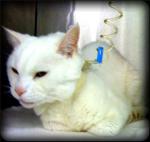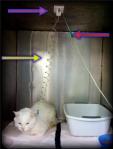The Best Cat i.v.
Sick Cats Need TLC
Cats are trickier to care for than most dogs.
In the US, there are about 5% more cat than dog households. About 65% to 60%. (That means, for all you pet lovers out there, 40% of households do not have a pet. Yes! 40%, Can you believe that?!) Yet cat medicine is still a new endeavor. Cats are not small dogs. We learned that in the 1970’s, when cats went blind and suffered dilated cardiomyopathy from lack of the essential amino acid taurine. Dogs and humans assemble their own taurine in the body. Cats do not. So the poor things were going blind and suffering heart attacks because no one knew!
Cats are tricky to hold, restrain, and work with. And they oftentimes hide their symptoms of illness until they are rip-roaring super-duper sick. A sick cat often needs intravenous fluids to save his or her life.
Many people ask Doc Truli, “How do you keep an i.v. in a cat?”
Well now, that’s a good question.
The SAIV i.v. Line
Pronounced “Save,” Dr. Donohue invented the SAIV i.v. system before Doc Truli’s time at the University of Pennsylvania New Bolton Center. Dr. Donohue is a ground-breaking equine surgeon who saw a need for an i.v. line that would not twist up into knots when a horse patient paced around a stall. He configured a coil i.v. line that runs up to the center of the enclosure above the patient’s head to a swivel base that spins with the patient.
The invention was held up in litigation for years. The University claimed anything the professor invented belonged to them. Dr. Donohue contended that he invented and perfected the thing at home, on his own time. After many years, Dr. Donohue prevailed and the SAIV system is now available to veterinary patients. The horse system was scaled into two smaller systems. One is cat and small dog sized, and a bigger i.v. line for large dogs.
The Jugular Intravenous Catheter
The jugular vein in the neck (incorrectly pronounced “Jag-you-lar” by Tigger from Winnie-the-Pooh) is a central line. This means it is a large-bore, main vein with direct access to the bloodstream. Blood samples obtained from a central line are more accurately analyzed; they have more intact cells and less cellular debris. The jugular provides a larger, quicker sample for blood. It is more comfortable for the cat than a peripheral intravenous line in a leg.

This cat is getting a cephalic peripheral vein catheter for a short-term procedure under anesthesia.
A peripheral intravenous line, such as the cephalic vein running along the inside of the foreleg, may be used as a back-up intravenous access, but it is less ideal than the jugular vein.
If the peripheral line is used, then an i.v. extension line runs up the leg to a bandage around the neck to offer a good bottom pivot point for the coil. If you do not run the i.v. up to the back of the neck, then the intravenous line will wrap around the cat’s leg when he or she walks.
The core SAIV system with a jugular catheter keeps the i.v. running in a cat and saves lives!






Trackbacks and Pingbacks